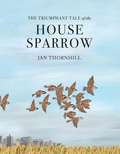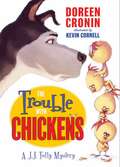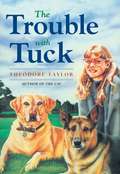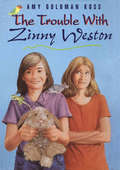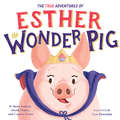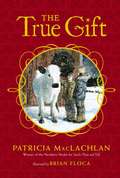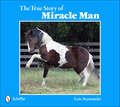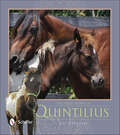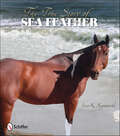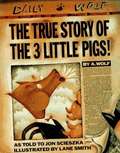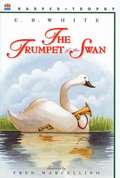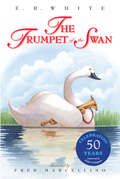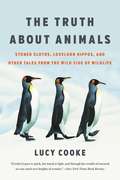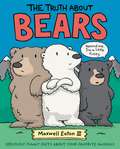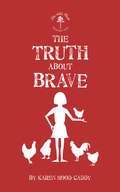- Table View
- List View
The Triumphant Tale of the House Sparrow
by Jan Thornhill“The content encourages us to reflect upon and evaluate the relationship between human beings and animals. This book leaves us with admiration for this feisty bird and hope for our world.” — Friends Journal Behold the most despised bird in human history!So begins Jan Thornhill’s riveting, beautifully illustrated story of the House Sparrow. She traces the history of this perky little bird, one of the most adaptable creatures on Earth, from its beginnings in the Middle East to its spread with the growth of agriculture into India, North Africa and Europe. Everywhere the House Sparrow went, it competed with humans for grain, becoming such a pest that in some places “sparrow catcher” became an actual job and bounties were paid to those who got rid of it.But not everyone hated the House Sparrow, and in 1852, fifty pairs were released in New York City. In no time at all, the bird had spread from coast to coast. Then suddenly, at the turn of the century, as cars took over from horses and there was less grain to be found, its numbers began to decline. As our homes, gardens, cities and farmland have changed, providing fewer nesting and feeding opportunities, the House Sparrow’s numbers have begun to decline again — though in England and Holland this decline appears to be slowing. Perhaps this clever little bird is simply adapting once more.This fascinating book includes the life history of the House Sparrow and descriptions of how the Ancient Egyptians fed it to the animals they later mummified, how it traveled to Great Britain as a stowaway on ships carrying Roman soldiers, and how its cousin, the Eurasian Tree Sparrow, was almost eradicated in China when Mao declared war on it. A wealth of back matter material is also supplied.Key Text Featuresmapglossaryreferencesresourcesfurther informationCorrelates to the Common Core State Standards in English Language Arts:CCSS.ELA-LITERACY.RI.3.3Describe the relationship between a series of historical events, scientific ideas or concepts, or steps in technical procedures in a text, using language that pertains to time, sequence, and cause/effect.CCSS.ELA-LITERACY.RI.3.7Use information gained from illustrations (e.g., maps, photographs) and the words in a text to demonstrate understanding of the text (e.g., where, when, why, and how key events occur).CCSS.ELA-LITERACY.RI.4.3Explain events, procedures, ideas, or concepts in a historical, scientific, or technical text, including what happened and why, based on specific information in the text.CCSS.ELA-LITERACY.RI.5.3Explain the relationships or interactions between two or more individuals, events, ideas, or concepts in a historical, scientific, or technical text based on specific information in the text.CCSS.ELA-LITERACY.RI.6.2Determine a central idea of a text and how it is conveyed through particular details; provide a summary of the text distinct from personal opinions or judgments.
The Trolley Ride (Fountas & Pinnell Classroom, Guided Reading Grade 1)
by Jennifer Gillis Deborah MelmonNIMAC-sourced textbook
The Trouble With Sunshine
by Yamile Saied MéndezA heartwarming story about grief and new beginnings, by Pura Belpré Award-winning author Yamile Saied Méndez.THE TROUBLE WITH SUNSHINE IS IT COMES EVEN IF YOU THINK YOU DON'T DESERVE IT.Dorani's mom, Isa, taught her to be bold and challenge the rules if they don't seem fair. People are more important than rules. But she never taught Dorani how to do it all without her. So, when Isa dies on the way to speak with the principal about Dori's latest revolution, Dori loses her voice. Her grief and guilt become the loudest parts of her.Moving from vibrant Miami to quiet, middle-of-nowhere Wyoming with her aunt feels like the punishment she deserves. She spends most of her time with their newest horse, Sunshine. Sunshine was involved in an accident that's left her skittish and hard to care for. Tia Ivette knows her behavior comes from fear, and she is trying everything to make Sunshine brave again. But Dori knows grief can feel like fear... and grief is just love with no place to go.Speaking up for Sunshine reminds Dori that the very best parts of her mother live on through her, and so when she starts to notice that the rules at her new school unfairly target specific students, she knows just what her mother would do...
The Trouble with Chickens
by Doreen Cronin Kevin CornellJ.J. Tully is a former search-and rescue dog who is trying to enjoy his retirement after years of performing daring missions saving lives. So he's not terribly impressed when two chicks named Dirt and Sugar (who look like popcorn on legs) and their chicken mom show up demanding his help to track down their missing siblings. Driven by the promise of a cheeseburger, J.J. begins to track down clues. Is Vince the Funnel hiding something? Are there dark forces at work-or is J.J. not smelling the evidence that's right in front of him? Bestselling author Doreen Cronin uses her deadpan humor to pitch-perfect effect in her first novel for young readers. Heavily illustrated with black-and-white artwork from Kevin Cornell, this new series is destined to become a classic.
The Trouble with Cupid
by Laura LangstonWhen a dog food company announces a competition to find a talented dog for their ad campaign, experienced dog trainer Erin agrees to work with the school entry: a lazy, gluttonous bulldog named Cupid.
The Trouble with Penguins
by Rebecca Jordan-GlumFor fans of Oliver Jeffers, Jon Klassen, and Jory John comes Rebecca Jordan-Glum's The Trouble with Penguins, a clever, irreverent debut picture book about an unlikely friendship between a penguin and a human that emphasizes the importance of sharing, patience, and, above all, friendship. On the day the penguin discovered the person, everything changed. The person was happy to see the penguin, and showed it how to roast marshmallows by the fire. When it was time for the penguin to go, she gave it her favorite roasting stick and a warm hug goodbye.Once the penguin showed its penguin friends how to roast marshmallows, they all wanted a turn. It was wonderful…until it wasn’t.You see, the trouble with penguins is that they don't always know how to say they're sorry. But, with a little help and teamwork, they discover sharing is always the best tactic.
The Trouble with Tuck
by Theodore TaylorA Girl's Best Friend "No one can definitely say when Friar Tuck began to go blind. But the light probably began to fail for big Tuck long before any of us suspected it, and of course, being a dog, he couldn't very well talk about it. It didn't seem possible. Young, beautiful, so free-spirited, he had a long life ahead. . . " Helen adored Tuck from the first moment he was placed in her arms, a squirming fat sausage of creamy yellow fur. And very soon Tuck returned her love. He faithfully slept on the rug beside her bed, guarded her against strangers, and rejoiced in their long walks together. So when Tuck began to lose his sight, Helen fought to be his eyes. She wouldn't let his blindness end his life or even limit it. Instead, Helen thought up a unique solution to Tuck's trouble, one that would keep Tuck free, proud, and hers forever.
The Trouble with Zinny Weston
by Amy Goldman KossZinny Weston has been Ava's best friend since the moment they met. There's only one problem: Ava's house is like a zoo, and Zinny's idea of a pet is a fur coat. When the Westons get a fishpond in their backyard, Ava hopes Zinny might finally be turning into an animal lover. Then a raccoon starts eating the fish, and soon the rumors start flying. What did Mrs. Weston do to eliminate her raccoon trouble? Who ratted on her to the Animal Protection Agency? Drawn into a nasty battle with Zinny over who did what, Ava wonders: Can they ever be friends again? Talented first novelist Amy Goldman Koss blends sensitivity and humor in this thought-provoking and often hilarious novel about animal rights and friendship.
The True Adventures of Esther the Wonder Pig
by Steve Jenkins Caprice Crane Cori Doerrfeld Derek WalterThe true story of social media sensation Esther the Wonder Pig and her two dads that inspired the New York Times bestselling memoir for adults is now available in a picture book with adorable illustrations and a message of love. <P>When Steve and Derek adopted a mini pig named Esther, they had no idea that she would turn out to be not-so-mini after all. When her new family saw just how big and wonderful Esther really was, they fell in love--and their lives changed forever. Esther would soon grow too large for her bed, and their small apartment. She got into everything, including her neighbor's tasty garden. <P>So the whole family moved from a small apartment to a big farm, where Esther and her animal friends could fit happily (and get into a little less mischief). Eventually, that farm would become the Happily Esther After animal sanctuary, home to rescued animals of all kinds.
The True Blue Scouts of Sugar Man Swamp
by Kathi AppeltMeet Bingo and J'miah, raccoon brothers on a mission to save Sugar Man Swamp in this tale from Newbery Honoree Kathi Appelt. <P><P>Raccoon brothers Bingo and J'miah are the newest recruits of the Official Sugar Man Swamp Scouts. The opportunity to serve the Sugar Man--the massive creature who delights in delicious sugar cane and magnanimously rules over the swamp--is an honor, and also a big responsibility, since the rest of the swamp critters rely heavily on the intel of these hardworking Scouts. Twelve-year-old Chap Brayburn is not a member of any such organization. But he loves the swamp something fierce, and he'll do anything to help protect it. And help is surely needed, because world-class alligator wrestler Jaeger Stitch wants to turn Sugar Man swamp into an Alligator World Wrestling Arena and Theme Park, and the troubles don't end there. There is also a gang of wild feral hogs on the march, headed straight toward them all. The Scouts are ready. All they have to do is wake up the Sugar Man. Problem is, no one's been able to wake that fellow up in a decade or four... <P><P>Newbery Honoree and National Book Award finalist Kathi Appelt presents a story of care and conservation, funny as all get out and ripe for reading aloud.
The True Gift
by Patricia Maclachlan Brian FlocaAll year long Lily and Liam look forward to Christmas on their grandparents' farm. It's always the perfect trip -- walking to the lilac library, trimming the tree, giving gifts. But this year, thanks to a white cow alone in the meadow, things will be different. This Christmas, Lily and Liam will find out the meaning of a true gift. From one of our most beloved authors comes a brand-new holiday classic that rings in the season by celebrating the joys of family, community, and true giving.
The True Meaning of Smekday: The Series That Inspired HOME (The Smek Smeries #1)
by Adam RexThe book that inspired HOME, now a major motion picture! It all starts with a school essay. When twelve-year-old Gratuity ("Tip") Tucci is assigned to write five pages on "The True Meaning of Smekday" for the National Time Capsule contest, she's not sure where to begin. When her mom started telling everyone about the messages aliens were sending through a mole on the back of her neck? Maybe on Christmas Eve, when huge, bizarre spaceships descended on the Earth and the aliens???called Boov???abducted her mother? Or when the Boov declared Earth a colony, renamed it "Smekland" (in honor of glorious Captain Smek), and forced all Americans to relocate to Florida via rocketpod? In any case, Gratuity's story is much, much bigger than the assignment. It involves her unlikely friendship with a renegade Boov mechanic named J.Lo.; a futile journey south to find Gratuity's mother at the Happy Mouse Kingdom; a cross-country road trip in a hovercar called Slushious; and an outrageous plan to save the Earth from yet another alien invasion. Fully illustrated with "photos," drawings, newspaper clippings, and comics sequences, this is a hilarious, perceptive, genre-bending novel from best-selling author Adam Rex.
The True Story of Corky, the Blind Seal
by Georgeanne IrvineYoung children will love Corky, a harbor seal who is orphaned. After being rescued he goes to the San Diego zoo where he learns to perform in shows. One day he can't find the ball. Corky is blind! But don't worry, Corky learns how to do his tricks by using his other senses. School-age kids will love this book because it is a true story and would be fun to read for a science project or a book report. Do you know how harbor seals and sea lions are different. Parents will love this story because it is the finest piece of literature which I have seen for introducing children to the ways people who are blind learn to cope with the disability. Absolutely no mythology here! Corky learns to do the things he has been doing by using sounds, smells and touch. Children's literature at its best! This file should make an excellent embossed braillle book.
The True Story of Miracle Man
by Lois SzymanskiThe story of heroic efforts taken to save a colt orphaned on Assateague IslandFrom orphan to a famous Chincoteague Pony herd sireDedication and unconventional medicine help the colt defy all odds
The True Story of Quintilius
by Lois SzymanskiThe newborn foal peered at Caroline from her computer screen. The online photo grabbed her heart. It was followed by photo after photo of the foal frolicking, rubbing noses with his momma, and nursing in the quiet of evening. This was the foal she knew she had to buy. Caroline had worked hard and saved all her money to buy a wild Chincoteague Pony foal and now she had fallen in love with the right one. She’d even named him "Quintilius" for the star that shone over the baby Jesus in the manger long ago. After she arrived on Chincoteague Island, Caroline volunteered for The Feather Fund and helped tag foals with the saltwater cowboys. Now, after all her hard work, the saltwater cowboys had labeled her foal—her Quintilus—for return to the island. Caroline couldn’t even consider of taking home another foal. Quintilius had won her heart. She’d poured herself into saving enough money and now it seemed the chestnut pinto colt would be forever out of her life. How could things be turned around for Caroline so that she could bring her foal home? Or would she lose her dream forever?
The True Story of Sea Feather
by Lois SzymanskiA family travels to Chincoteague Island, Virginia, to see the annual wild pony penning auction. One daughter, Shannon, has saved her money and hopes to buy a pony. Events transpire unexpectedly and end happily. Shannon learns that in life, you get what you give. Middle grades–ages 8-12.
The True Story of Stellina
by Matteo PericoliStellina was a bird: "CHEEP." A very little bird: "Cheep! cheep!"So begins critically acclaimed author Matteo Pericoli's all-true story of how he and his wife, Holly, came to rescue and raise a little finch, Stellina, in the middle of New York City. When no zoo would take the abandoned bird, fallen from her nest onto a busy street, Holly took her home and gave her the best life she could. And there, in a Manhattan apartment, Stellina leaned how to eat, fly, and sing.
The True Story of the 3 Little Pigs
by Jon Scieszka Lane SmithA spoof on the three little pigs story. The wolf gives his own outlandish version of what really happened when he tangled with the three little pigs. Images and image descriptions available.
The True Tails of Baker and Taylor: The Library Cats Who Left Their Pawprints on a Small Town . . . And the World
by Lisa Rogak Jan Louch"Not since George Bailey in It's a Wonderful Life has someone so lifted the spirits of an entire community. That the 'someone' in this case is, in fact, two library cats makes this true tale of the love of literature combined with a fondness for nose licking all the more magical. This book, like a purring kitten who may also be a genie, should be welcomed into any home."—Francesco Marciuliano, New York Times bestselling author of I Could Pee on This: And Other Poems by Cats It all started with mice in the library. Assistant librarian Jan Louch and a coworker decided that what the library needed was a cat. Or, even better, two cats. Soon, they found a pair of Scottish Folds who were perfect for the job. Jan named them Baker and Taylor, and they took up residence in the library. But these cats were much more than mousers. Visitors to the library fell in love with Baker and Taylor and their antics just as Jan had. And then, after Jan let the cats be photographed for a poster, they became feline celebrities. Children from across the country wrote them letters, fans traveled from far and wide to meet them, and they became the most famous library cats in the world. In The True Tails of Baker and Taylor, Jan Louch looks back and tells the remarkable story of these two marvelous cats and the people—readers, librarians, and cat lovers of all ages—who came together around them.
The Trumpet of the Swan
by E. B. WhiteLike the rest of his family, Louis is a trumpeter swan. But unlike his four brothers and sisters, Louis can't trumpet joyfully. In fact, he can't even make a sound. And since he can't trumpet his love, the beautiful swan Serena pays absolutely no attention to him. Louis tries everything he can think of to win Serena's affection--he even goes to school to learn to read and write. But nothing seems to work. Then his father steals him a real brass trumpet. Is a musical instrument the key to winning Louis his love?
The Trumpet of the Swan
by E. B. White Fred MarcellinoNow available for the first time as an ebook! Illustrations in this ebook appear in vibrant full color on a full-color device and in rich black-and-white on all other devices.This beloved book by E. B. White, author of Charlotte's Web and Stuart Little, is a classic of children's literature that perfectly describes what it's like to march to the beat of your own drummer.Louis is a trumpeter swan, but unlike the rest of his family, he can't make a sound. And since he can't trumpet his love, the beautiful swan Serena pays no attention to him. But when his father steals him a real brass trumpet, Louis has to find out if it's the key to what he's wanted all along.E. B. White's classic book is a tender novel of overcoming the odds and learning to do things on your own terms. It will continue to be enjoyed by generations to come. It contains evocative illustrations by Fred Marcellino, the acclaimed illustrator of Puss in Boots and I, Crocodile, among many other books.Correlates to the Common Core State Standards in English Language Arts
The Truth About Animals: Stoned Sloths, Lovelorn Hippos, and Other Tales from the Wild Side of Wildlife
by Lucy CookeMary Roach meets Sam Kean and Bill Bryson in this uproarious tour of the basest instincts and biggest mysteries of the animal worldHumans have gone to the Moon and discovered the Higgs boson, but when it comes to understanding animals, we've still got a long way to go. Whether we're seeing a viral video of romping baby pandas or a picture of penguins "holding hands," it's hard for us not to project our own values--innocence, fidelity, temperance, hard work--onto animals. So you've probably never considered if moose get drunk, penguins cheat on their mates, or worker ants lay about. They do--and that's just for starters. In The Truth About Animals, Lucy Cooke takes us on a worldwide journey to meet everyone from a Colombian hippo castrator to a Chinese panda porn peddler, all to lay bare the secret--and often hilarious--habits of the animal kingdom. Charming and at times downright weird, this modern bestiary is perfect for anyone who has ever suspected that virtue might be unnatural.
The Truth About Bats (Fountas & Pinnell LLI Gold #Level O)
by Margaret AshaEeek! If s a Bat! Why are people afraid of bats? It's true that bats have a bad reputation--think witches, haunted castles, Halloween. But what people believe about bats isn't necessarily correct. Learn the truth behind the myths about bats.
The Truth About Bears: Seriously Funny Facts About Your Favorite Animals (The Truth About Your Favorite Animals)
by Maxwell Eaton IIIMaxwell Eaton III's The Truth About Bears is a lighthearted nonfiction picture book, filled with useful facts about bears that will make you laugh so hard you won’t even realize you’re learning something!
The Truth About Brave
by Karen Hood-CaddyIs Robin brave enough to do what’s right when everyone thinks she’s wrong? No one is more passionate about rescuing hurt animals than Robin, except maybe her best friend Zo-Zo, who helps Robin run the family’s animal shelter, The Wild Place. When the two of them discover that a neighbour’s chicken farm is really a factory farm, they both want to stop it. Zo-Zo argues that radical action is required, but Robin is worried about getting into trouble with her dad, or even worse, the local sheriff. Is it ever okay to break the law to stand up for what you believe in? And if it is, how will she find the courage to do what’s right, even when others think she’s wrong?
